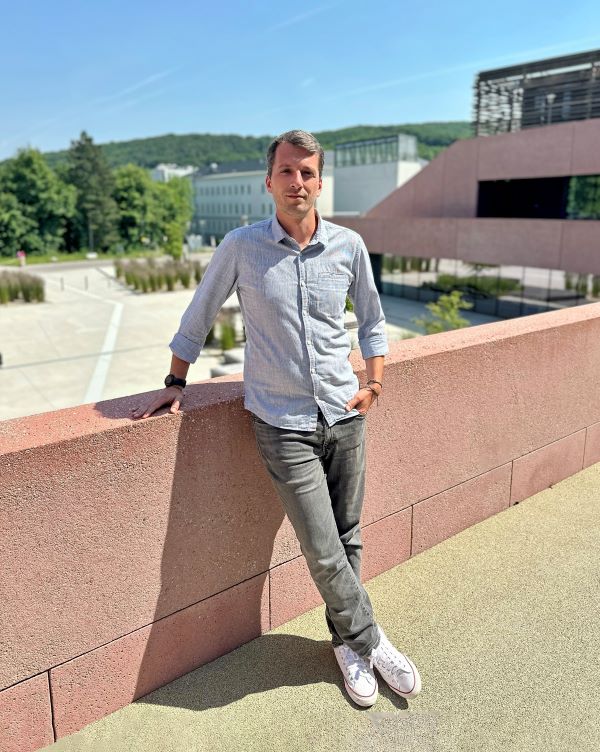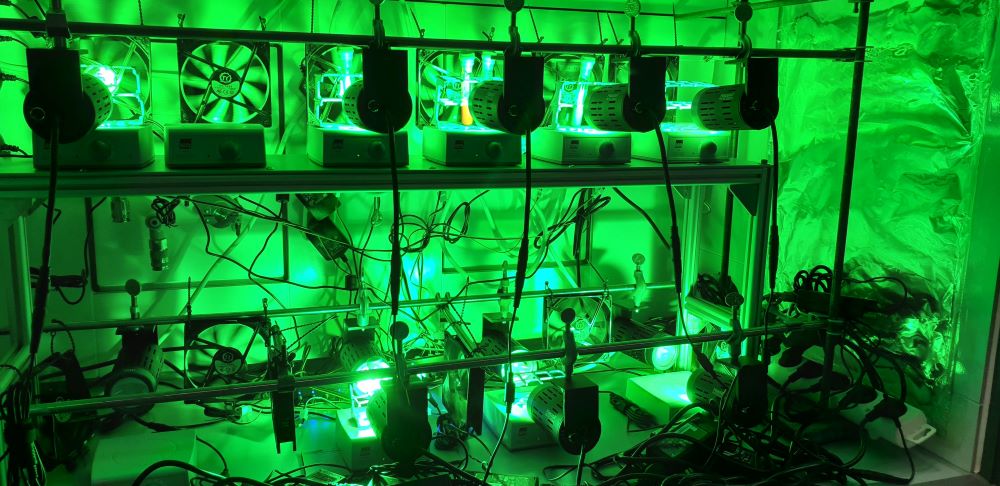July 4, 2023
The Power of Light
New assistant professor at ISTA develops chemical reactions powered by light
The Institute of Science and Technology Austria (ISTA) welcomes Assistant Professor Bartholomäus Pieber. The chemist started in June and tries to harness the power of light as an energy source for synthetic chemistry. With his team, he develops novel reactions that are fueled by visible light, aiming to provide powerful and sustainable strategies for the synthesis of fine chemicals such as pharmaceuticals.

Lacing up his running or hiking shoes and heading into nature is part of Bartholomäus Pieber’s routine. It clears his mind and creates space for new ideas, which have already taken him from the University of Graz to the Max Planck Institute in Potsdam and now to ISTA. Together with his team, the young group leader strengthens the chemistry portfolio at the Institute.
Inspired by nature
Pieber’s research group, the PieberLab, focuses on organic synthesis—a subdiscipline of chemistry that studies methods and strategies to construct complex molecules from simple starting materials. “It’s like Lego—many small building blocks, which you put together in a controlled way to obtain something bigger with a specific function, like a house or a car. That’s what we do in our lab, just on a molecular level,” Pieber explains.
Such processes require energy and chemists typically apply heat to fulfill this need. Nature, on the other hand, assembles complex molecules from water and carbon dioxide using sunlight as a renewable energy source (photosynthesis). Pieber’s team takes this as inspiration and develops synthetic methods that harness light as an energy source with many advantages: visible light is safe and easy to use, produces no waste, and even accesses reactions that are hard or impossible to perform by any other means.
“You need a specific ingredient in your reaction cocktail that enables the use of visible light as fuel for a chemical reaction. We call this a photocatalyst,” Pieber explains. A photocatalyst is a substance that converts the energy of light into “chemical energy”, without itself being consumed. Most common photocatalysts are based on noble metals, such as ruthenium or iridium. Pieber’s research group focuses on the development of cheaper and more sustainable photocatalysts, including semiconducting materials or polymers. “The availability, cost, and toxicity of noble metals are limitations. We work on readily accessible, cheap, and benign molecules and materials that can also be reused,” says Pieber.
Remote control with light — the wavelength matters
Besides looking for suitable catalysts, the PieberLab also investigates whether light offers a new way to control chemical reactions. “If you send light through a glass prism or water drops, it splits into multiple colors—this is how rainbows are formed in nature. Each of these colors corresponds to a different wavelength and thus also a different energy,” Pieber explains.

Violet light, for instance, has a lot of energy, but it is the even more energetic ultraviolet light that causes sunburn on our skin. Green or red light, on the other hand, is lower in energy and cannot harm you. “In our lab, we are studying how we can use light with different wavelengths to selectively initiate and control reactions using tailored photocatalysts,” Pieber continues. “This allows us to switch between different outcomes of reactions depending on the color of light.”
Engineering drugs with light
The photocatalysts and methods that are studied by Pieber and his team can be used for a wide variety of applications, such as new ways of producing pharmaceuticals. The reactions developed by the team are also applied by other scientists to make complex natural products. However, Pieber is particularly excited about the possibility of using light-driven reactions to treat diseases.
“It is possible to trigger chemical reactions with light in your body,” Pieber says. In doing so, one takes advantage of the fact that light with low energy can penetrate tissue. For the chemist, the long-term vision for his research is clear, “Remotely activating a drug precursor at the right position in our body or even making an active drug from building blocks using light directly is an extremely exciting emerging research area. There are numerous challenges before this can become a reality, but I strongly believe that photocatalytic reactions could change the way we treat certain diseases.”
Pieber now has all the resources and prerequisites at ISTA to implement his ideas. “I am fascinated by the excitement on campus, the fresh air, the opportunity to break new ground, and, above all, the great scientists from many different areas with whom you can collaborate. ISTA is really a unique place,” adds the chemist.
The newly furnished and customized laboratory is ready and the Viennese Woods and nearby mountains offer many routes for Pieber’s running and hiking routine.



